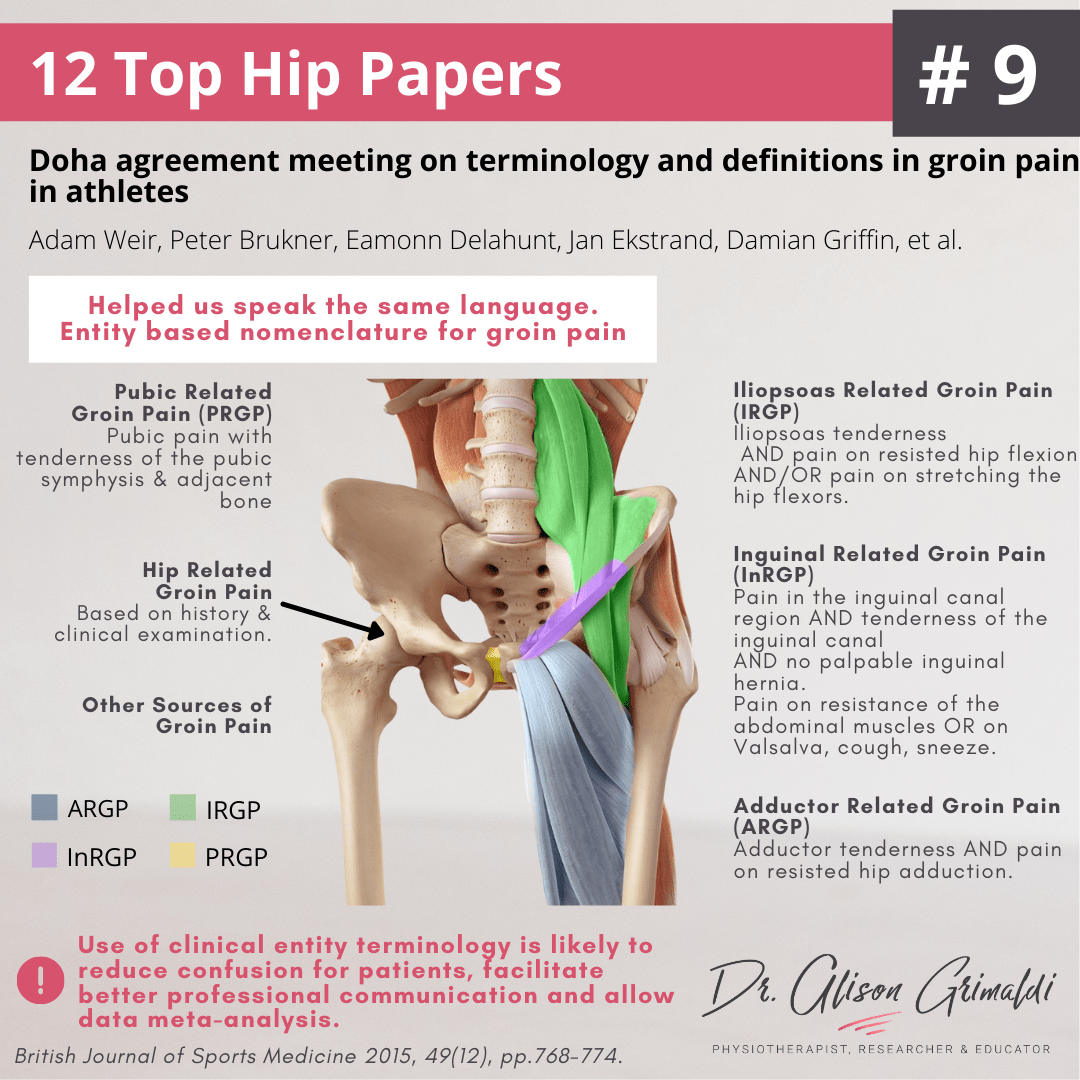9 of 12 Top Hip Papers – Defining Groin Pain Entities

Only 4 more top papers left in this 12 Top Hip Papers miniblog series. So far we have explored some fantastic papers on hip joint related conditions, hip muscle function and nerve related pain. If you missed any of these, head back to the main blogpage. Today, for Day 9, we are moving a little more medially to the groin. This paper helped us speak the same language, defining groin pain entities. I hope you enjoy the infographic and key learnings from this paper.

For your convenience, we have also developed this content into a FREE 26-page full colour ebook!
Packed full of 12 Top Hip Papers - peer reviewed scientific papers that have contributed to our understanding of hip conditions and/or the assessment or management of hip pain or injury.
PAPER 9: Doha agreement meeting on terminology and definitions in groin pain in athletes
Experts in this area came together to address the problem of the large number and inconsistency of diagnostic terms used for groin pain. Such variation is confusing for patients, limits communication between health professionals, interpretation of research and meta-analyses across studies. The aim was to replace variable terms for similar presentations of groin pain with simple categories and entities that can be determined by the clinician from the patient’s history, area of pain and clinical examination.
‘Adductor related groin pain’ – pain in the adductor region with history and physical examination consistent with adductor pain or injury, was suggested in place of terms such as adductor tendinopathy, adductor enthesopathy, adductor tendinitis, adductor strain or adductor tear.
‘Iliopsoas related groin pain’ – pain in the iliopsoas region, more lateral to the adductor region, with history and physical examination consistent with iliopsoas pain or injury covers injuries of the iliacus and or psoas muscles, tendons or musculotendinous junctions and replaces terms such as iliopsoas tendinitis or tendinopathy, tear or strain.
‘Inguinal related groin pain’ – pain in the inguinal region with history and physical examination consistent with pain or injury to the inguinal soft tissues, covers diagnoses/pathologies such as sports hernia, sportsman’s hernia, incipient hernia, inguinal disruption, Gilmore’s groin, inguinal canal aponeurosis strain, ilioinguinal disruption, superficial inguinal ring insufficiency, enthesopathy inguinal ligament, enthesopathy of the conjoined tendon, posterior wall weakness and core muscle injury.
‘Pubic related groin pain’ – pain in the pubic region with history and physical examination consistent with pain or injury to the pubic structures, covers diagnoses/pathologies such as pubic bone stress injury, pubic bone fibrocartilage separation, pubic aponeurosis tear, osteitis pubis, osteoarthritis of the pubic symphysis, pubic bone marrow oedema and pubic plate tear.
Other sources of groin pain were acknowledged and categorised as Hip Related Groin Pain, emanating from the hip joint, and Other Causes of Groin Pain, including any other orthopaedic, neurological, rheumatological, urological, gastrointestinal, dermatological, oncological, or surgical condition causing pain in the groin region.

Key learnings about groin pain entities:
The consensus was that groin pain in athletes should be divided into three major categories:
- Defined clinical entities for groin pain: adductor-related, iliopsoas-related, inguinal-related and pubic-related groin pain.
- Hip-related groin pain, and
- Other causes of groin pain.
Diagnosis of groin pain through clinical entities determined via history and physical examination, was recommended to ensure consistency of nomenclature in both clinical practice and research.
Consensus update on groin pain entities - 5 years later
An update has also just recently been published. This new paper aimed to evaluate the adoption of the classification system amongst the Doha agreement experts and the wider community of clinicians. The experts also discussed how the classification system may be improved.
Adoption of the Doha agreement classification system was reported by the majority of participants - 73-82% of the Doha meeting experts and 57-69% of clinicians completing the electronic survey , indicating that most find the system clinically useful. Further clinical translation is still required as some of the e-survey participants were unaware of the Doha agreement entities. The paper reports some interesting discussion from the expert panel, reflecting on this system 5 years later. A key theme was discussion around development of subclassifications, where these distinctions would change clinical management. One of the difficulties highlighted was the lack of evidence to clearly subcategorise the entities. Further research is needed to assist here and the experts also identified that the role of Magnetic Resonance Imaging (MRI) findings needs to be clarified. MRI may assist in possible sub-categorisations that involve bone, with these presentations requiring a different clinical approach.
The two statements that reached >75% agreement of the experts were:
- The role of MRI findings needs to be further clarified to improve the Doha agreement meeting classification.
- Pubic bone stress, pubic stress fracture and pubic apophysitis should be differentiated since these diagnoses may provide clarification and have a different prognosis and management.
In summary then, this update shows that the groin pain entities have been clinically useful but are not perfect, with the aim over time to establish some clear subcategories as evidence arises to support these. At this stage, experts agree that bone injury should be differentiated. Further evidence is required to clearly subcategorise other entities.
You'll find a link to my anterior hip and groin pain course below, if you would like to learn more about groin pain. This course is also included in Hip Academy.

Join Hip Academy Today
Join Hip Academy Today
By becoming a member today you can enjoy the benefits of a world class educational Hip Program, specifically designed by Dr Alison Grimaldi to help improve your knowledge surrounding the Hip and Pelvis, and become an expert in your field.
By becoming a member today you can enjoy the benefits of a world class educational Hip Program, specifically designed by Dr Alison Grimaldi to help improve your knowledge surrounding the Hip and Pelvis, and become an expert in your field.
Reference



